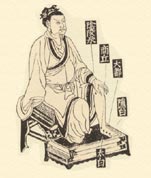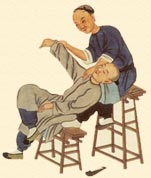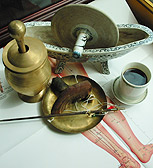The Huang Di Nei Jing (The Yellow Emperor's Classic of internal Medicine) says, "The twelve Meridian System is: the process through which our body grows; the explanation how disease continues and develops; the methods by which our body is treated; the place where disease occurs; the concept where philosophy begins, the target where successful outcome should be achieved." This saying illustrates the importance of the meridian theory in human physiology, pathology, diagnosis and therapeutics in TCM.
 Physiological application
Physiological application
The Huang Di Nei Jing (The Yellow Emperor's Classic of internal Medicine) also says, "The Meridians move the Qi and Blood. As a result, Yin and Yang get regulated. Tendons and bones get nourished. Joints get facilitated."
Meridians work like a network system, transporting and distributing qi and blood. They link up organs, limbs, joints, bones, tendons, tissues and skin, and provide communication between the body's interior and exterior. Through a healthy Meridian System, Qi and Blood successfully warm and nourish different organs and tissues, and maintain normal metabolic activities. Meridians are essential in supporting the flow of nutritive Qi inside the blood vessels and the flow of protective Qi around them. In addition, they strengthen the body's immunity, protect against external pernicious influences (anything evil that causes disease) and assist in regulating yin and yang,
 Pathological application
Pathological application
In Chinese Medicine, the "evils" (pathogenic influences) transform and progress along the meridians to attack the body and cause disease or illness. They are classified in TCM as wind, fire, dampness, dryness, cold and summer heat. Sometimes, the evil travels from one organ to other, but it can proceeds from the exterior to the interior of the body.
A common example is the development of influenza, which TCM believes is caused by external influences. Initially, the person with influenza presents with fever, dislike of cold, headaches, and body pains. The evil may subsequently progress along the closest Lung Meridian and launch an attack on the lungs. When this occurs, the person may suffer from common complications of influenza such as a cough, wheezing and chest pain.
Disharmony of one organ can also affect other organs because of their interconnections through the Meridian System. For instance, liver disharmony can influence the stomach, and stomach disharmony can influence the spleen. Moreover, organ disharmony inside the body will show pathological changes along the Meridian channel with which it is associated. For example, liver disharmony can cause lower chest pain, because the liver meridian passes through lower chest region. Kidney disharmony can cause groin pain, because the kidney meridian crosses the groin area. Ulcers on the tip of tongue can suggest heart disharmony since the heart meridian has branches at the tip of tongue.
Diagnostic Application
Because of the special properties of meridians, disharmony and imbalance in the body can be diagnosed according to the meridian and its corresponding organ. Headaches, for example, are classified according to their affected painful spots and the distribution of the meridians in that area. Pain in the forehead indicates a Yang Ming Meridian type headache, while pain in both sides of head indicates a Shao Yang Meridian type headache. Back and neck pain is a Tai Yang Meridian type headache, and pain in the top of head indicates the Jue Yin Meridian type headache. Such specific diagnoses help tailor individual treatment plans allowing for the best outcome for relief of the headache.
Another common example is the presentation of liver disharmony. Because the liver meridian passes through the lower chest and lower abdomen, pain in those areas may indicate problems in the liver and not other organs. When organ disharmony occurs, usually the corresponding meridian and acupuncture points demonstrate morphological changes, and it can feel painful when these points are pressed. All these Meridian-related presentations and symptoms assist in TCM diagnosis. The Meridian System is the basis of the well-known Six Meridian differential diagnostic method, which was conceived by a famous and distinguished Chinese Medicine physician in the Han dynasty named Zhang Zhongjing (2nd to 3rd century AD). His diagnostic method had a significant impact on the future development of TCM.
Application in herbal treatment and acupuncture therapy
 Understanding the Meridian System and its relationship with the body's organs is essential in guiding herbal treatment and acupuncture therapy. Chinese medicine always aims to resume the harmony of yin and yang and maintain the flow of qi and blood. Acupuncture exerts its therapeutic effects by replenishing, balancing and moving the flow of qi throughout the body so normal organ functions and harmony can be resumed.
Understanding the Meridian System and its relationship with the body's organs is essential in guiding herbal treatment and acupuncture therapy. Chinese medicine always aims to resume the harmony of yin and yang and maintain the flow of qi and blood. Acupuncture exerts its therapeutic effects by replenishing, balancing and moving the flow of qi throughout the body so normal organ functions and harmony can be resumed.
Meridian differential diagnosis is essential for both herbal treatment and acupuncture therapy. In TCM, herbal medicines are chosen specifically for treating certain meridians and their corresponding organs. Moreover, some herbs have meridian guiding properties, which help potentiate the therapeutic effects of specific organs and meridians. In this way, meridians allow for an individually tailor-made herbal treatment plan according to a patient's disharmony pattern.
Similarly, understanding meridian selectivity is important for optimal therapeutic outcomes with acupuncture. For example, a headache in the forehead region is diagnosed as Yang Ming Meridian disharmony. Acupuncture points in Arm Yang Ming Meridian such as Hegu (the depression on the dorsum of the hand between the first and second metacarpal bones, at the level of the middle of the second metacarpal bone) can be selected to treat this type of headache. Another common example is a stomach ache (indigestion, dyspepsia). Since the stomach belongs to the Leg Yang Ming Meridian, the corresponding acupuncture point of Zusanli (located: one finger-breadth lateral to the anterior crest of tibia) can be chosen to relieve this pain.
In conclusion, the Meridian System remains an important and integral part of Traditional Chinese Medicine, and the application of herbal therapies and acupuncture continues to be essential in restoring the balance of health in our bodies.
 Physiological application
Physiological application The Huang Di Nei Jing (The Yellow Emperor's Classic of internal Medicine) also says, "The Meridians move the Qi and Blood. As a result, Yin and Yang get regulated. Tendons and bones get nourished. Joints get facilitated."
Meridians work like a network system, transporting and distributing qi and blood. They link up organs, limbs, joints, bones, tendons, tissues and skin, and provide communication between the body's interior and exterior. Through a healthy Meridian System, Qi and Blood successfully warm and nourish different organs and tissues, and maintain normal metabolic activities. Meridians are essential in supporting the flow of nutritive Qi inside the blood vessels and the flow of protective Qi around them. In addition, they strengthen the body's immunity, protect against external pernicious influences (anything evil that causes disease) and assist in regulating yin and yang,
 Pathological application
Pathological application In Chinese Medicine, the "evils" (pathogenic influences) transform and progress along the meridians to attack the body and cause disease or illness. They are classified in TCM as wind, fire, dampness, dryness, cold and summer heat. Sometimes, the evil travels from one organ to other, but it can proceeds from the exterior to the interior of the body.
A common example is the development of influenza, which TCM believes is caused by external influences. Initially, the person with influenza presents with fever, dislike of cold, headaches, and body pains. The evil may subsequently progress along the closest Lung Meridian and launch an attack on the lungs. When this occurs, the person may suffer from common complications of influenza such as a cough, wheezing and chest pain.
Disharmony of one organ can also affect other organs because of their interconnections through the Meridian System. For instance, liver disharmony can influence the stomach, and stomach disharmony can influence the spleen. Moreover, organ disharmony inside the body will show pathological changes along the Meridian channel with which it is associated. For example, liver disharmony can cause lower chest pain, because the liver meridian passes through lower chest region. Kidney disharmony can cause groin pain, because the kidney meridian crosses the groin area. Ulcers on the tip of tongue can suggest heart disharmony since the heart meridian has branches at the tip of tongue.
Diagnostic Application
Because of the special properties of meridians, disharmony and imbalance in the body can be diagnosed according to the meridian and its corresponding organ. Headaches, for example, are classified according to their affected painful spots and the distribution of the meridians in that area. Pain in the forehead indicates a Yang Ming Meridian type headache, while pain in both sides of head indicates a Shao Yang Meridian type headache. Back and neck pain is a Tai Yang Meridian type headache, and pain in the top of head indicates the Jue Yin Meridian type headache. Such specific diagnoses help tailor individual treatment plans allowing for the best outcome for relief of the headache.
Another common example is the presentation of liver disharmony. Because the liver meridian passes through the lower chest and lower abdomen, pain in those areas may indicate problems in the liver and not other organs. When organ disharmony occurs, usually the corresponding meridian and acupuncture points demonstrate morphological changes, and it can feel painful when these points are pressed. All these Meridian-related presentations and symptoms assist in TCM diagnosis. The Meridian System is the basis of the well-known Six Meridian differential diagnostic method, which was conceived by a famous and distinguished Chinese Medicine physician in the Han dynasty named Zhang Zhongjing (2nd to 3rd century AD). His diagnostic method had a significant impact on the future development of TCM.
Application in herbal treatment and acupuncture therapy
 Understanding the Meridian System and its relationship with the body's organs is essential in guiding herbal treatment and acupuncture therapy. Chinese medicine always aims to resume the harmony of yin and yang and maintain the flow of qi and blood. Acupuncture exerts its therapeutic effects by replenishing, balancing and moving the flow of qi throughout the body so normal organ functions and harmony can be resumed.
Understanding the Meridian System and its relationship with the body's organs is essential in guiding herbal treatment and acupuncture therapy. Chinese medicine always aims to resume the harmony of yin and yang and maintain the flow of qi and blood. Acupuncture exerts its therapeutic effects by replenishing, balancing and moving the flow of qi throughout the body so normal organ functions and harmony can be resumed.Meridian differential diagnosis is essential for both herbal treatment and acupuncture therapy. In TCM, herbal medicines are chosen specifically for treating certain meridians and their corresponding organs. Moreover, some herbs have meridian guiding properties, which help potentiate the therapeutic effects of specific organs and meridians. In this way, meridians allow for an individually tailor-made herbal treatment plan according to a patient's disharmony pattern.
Similarly, understanding meridian selectivity is important for optimal therapeutic outcomes with acupuncture. For example, a headache in the forehead region is diagnosed as Yang Ming Meridian disharmony. Acupuncture points in Arm Yang Ming Meridian such as Hegu (the depression on the dorsum of the hand between the first and second metacarpal bones, at the level of the middle of the second metacarpal bone) can be selected to treat this type of headache. Another common example is a stomach ache (indigestion, dyspepsia). Since the stomach belongs to the Leg Yang Ming Meridian, the corresponding acupuncture point of Zusanli (located: one finger-breadth lateral to the anterior crest of tibia) can be chosen to relieve this pain.
In conclusion, the Meridian System remains an important and integral part of Traditional Chinese Medicine, and the application of herbal therapies and acupuncture continues to be essential in restoring the balance of health in our bodies.







No comments:
Post a Comment